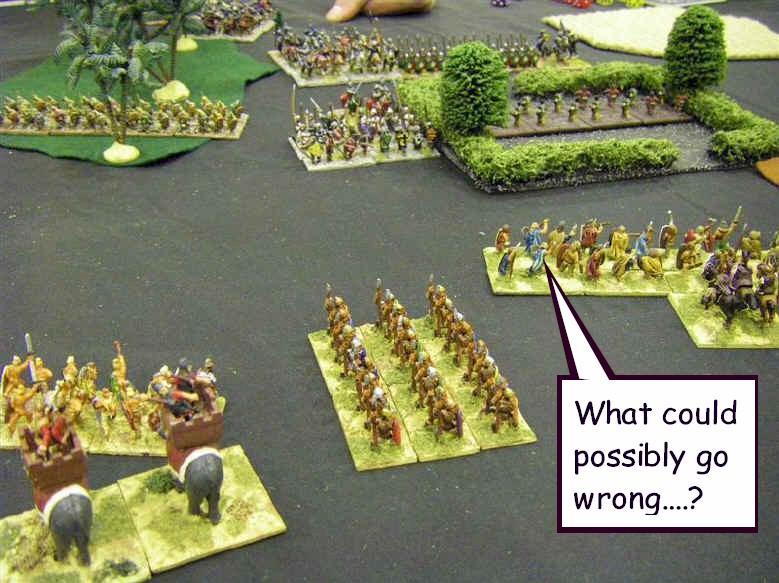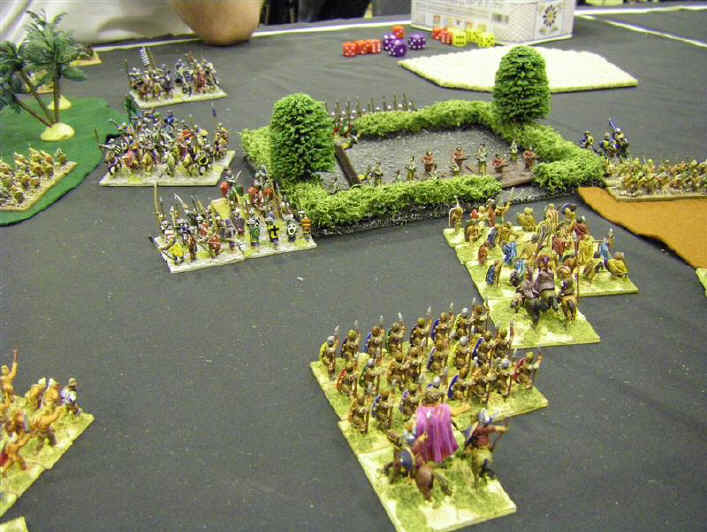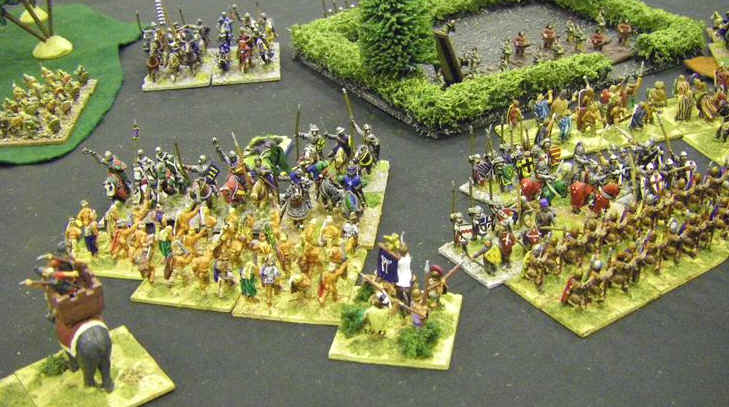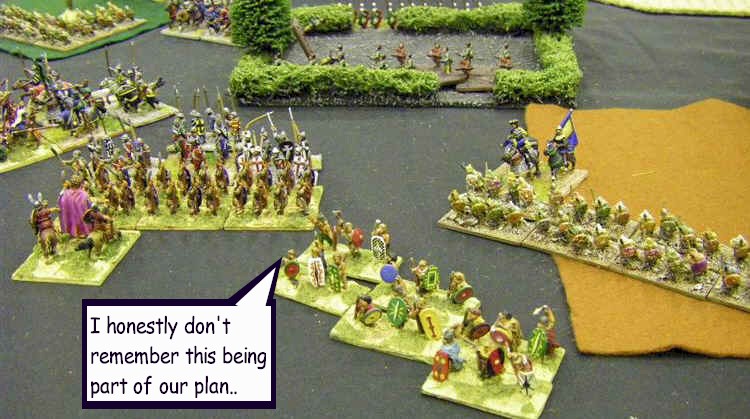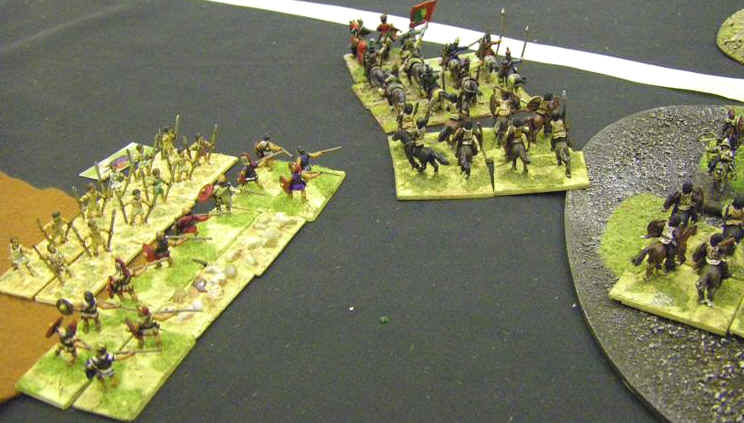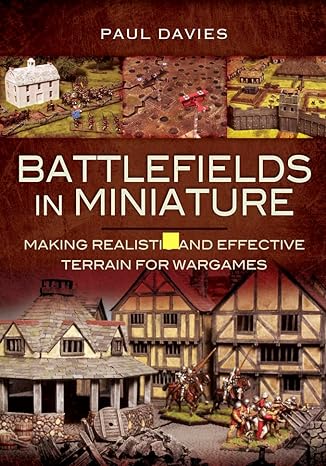Ascot 2008 Field of Glory Competition
Game 3
 With a win and a loss (erm, crushing and humiliating defeat actually) under
my belt I was of course highly confident. The defeat had been down to bad dice
plain and simple, and I'd proven I could beat a medieval army so what could
possibly go wrong ?
With a win and a loss (erm, crushing and humiliating defeat actually) under
my belt I was of course highly confident. The defeat had been down to bad dice
plain and simple, and I'd proven I could beat a medieval army so what could
possibly go wrong ?
It was just a temporary blip right?
Game 3 saw me facing off against another Medieval army - go good news there then. This time it was the Crown of Aragon or some more knights and maybe some almughavars - whatever they were !
But wither way it was another medieval army - and no more damn Romans!!
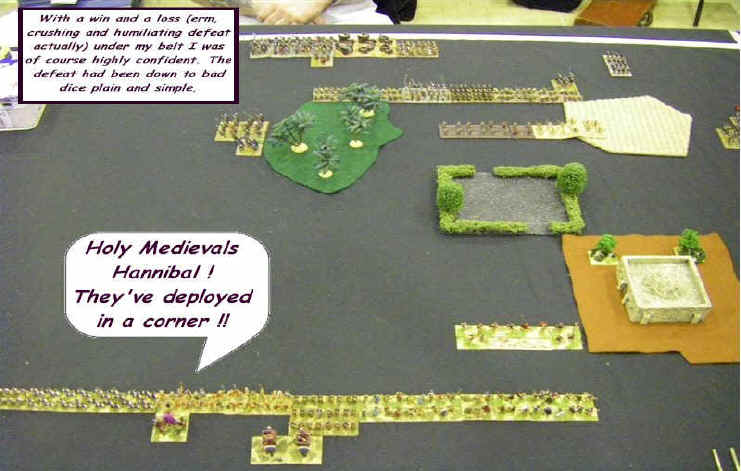
This time the terrain fell almost all in one corner of the field of battle, leaving me expecting a DBM-style deployment from the Spanish with their knights rolling forward over the open ground to my left. I was trying the Elephant trick again as well - just because I could!
The Aragonese however confounded me with a whacky deployment, with everything shoved in the woods. But at least the spirit of DBM wasn't totally dead as they did send out a couple of light horse to delay my advance whilst they redeployed slightly behind the screen

On the far right my Numidians faced up to the prospect of their first encounter with a more well developed and evolved alien life form - Medieval Light Horse...
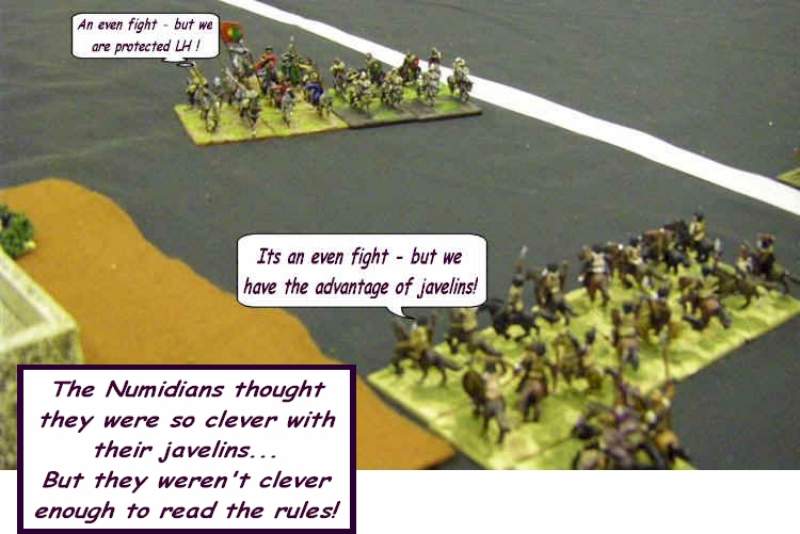
The game was developing in a way I was finding difficult to predict - which was strangely invigorating.
So, as usual, my response was to rush forward and get stuck in, so that as long as the fighting started early enough, my opponent may not have time to execute his plan!!
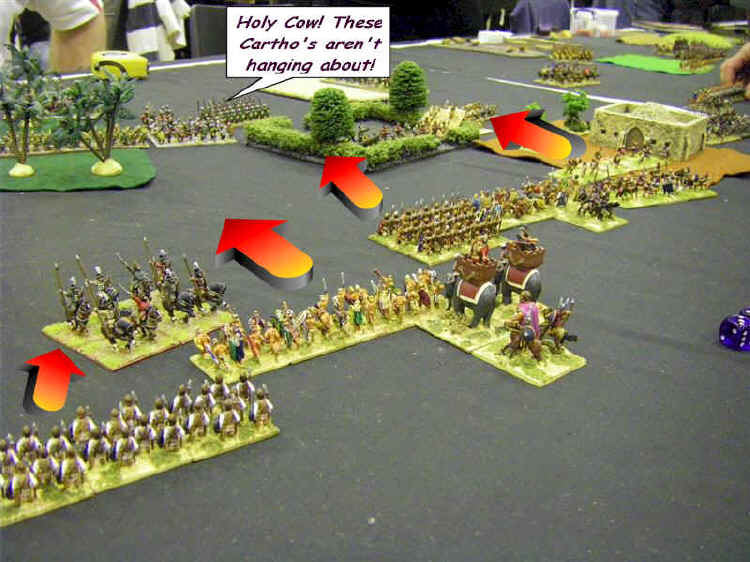
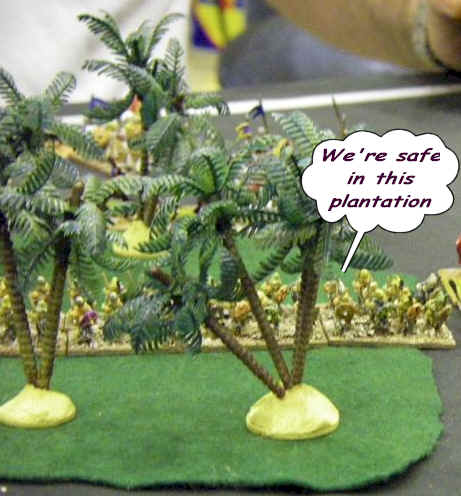 The
feared Almuggghavars were not really doing too much and were occupying the
middle of the table by lurking in a plantation to protect the flanks of the
spearmen
The
feared Almuggghavars were not really doing too much and were occupying the
middle of the table by lurking in a plantation to protect the flanks of the
spearmen
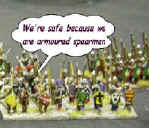
The main advance of my army was starting to run into trouble as across the table my skirmishers were encountering vastly superior forces - the Numidians were particularly upset to discover that they were no where near as good as the protected crossbowmen they were being chased down by, and were forced into a humiliating retreat. This prompted my Spanish caetrati to turn tail to harass the flanks of the pesky mounted crossbowmen, trusting in their medium foot brothers to shoo away the enemy javelinmen in the village.
In the center I attempted to use the greater maneuvering power of my drilled Bruttians to provide rear support for my Gauls - also try try and create some room for my Gauls and elephants, as the Spanish spearmen seemed in no hurry to advance out of their secure position. The Gauls started to bang their shields eagerly as they relished the prospect of sweeping some pesky light bowmen out of a hedge-enclosed field. Taking this position would give me ownership of a key pivot point on the battlefield, threatening the flanks of the Spanish to left and right.
The Spanish light horse were now also being gradually enveloped by a vastly overpowered Carthaginian force that was attempting to claw some salvation from their initially out-deployed start position. But this was not DBM - maybe they could squirt their way out of trouble ?
Swinging back to the right, the protected Spanish light horse had pushed the Numidians back, but the Carthaginian- owned Spanish foot were now in a position to add the weight of their missiles to the equation. What would the effect be ? If I could disrupt the light horse they would be on a slippery slope to defeat... but they had a secret weapon - their own General !
With the camera panning back to the middle, the scene unfolds below with the confident Celts forming up into a deep formation to rush the field, and also to make room for the armoured superior Bruttians and the wild and hairy close formation Celtiberian swordsmen to slam into the Spanish spearmen - hopefully before those pesky knights arrive!
Oops - well, as the next picture shows, that didn't quite work then...
The Spanish knight managed to maneuver past their spearmen as the IGO UGO
nature of the game again eluded me - and even worse, the Gauls (top right) had
suffered fearsome shooting damage from the light archers hiding in the bocage -
dropping them to disrupted  (disrupted marker)
(disrupted marker)
With the room for maneuver quickly becoming eroded, the better articulated Medieval Spaniards were starting to run rings round their ancestors and in the town some drilled Almughavars appeared out of the back passages of the hamlet to confront my own Spanish - it was an even fight apart from the fact the Almughavars were better armoured, had better morale and outnumbered my forces by 33%
Throwing all my available generals into support their troops I attempted to hold the Almughavars whilst repairing the morale and cohesion of my Gauls. But everywhere I had a general, the Spanish had one too - and usually leading better troops!
My Celtiberians formed up in a deep formation and bravely took on the Spanish tin can wearers - and scored an unlikely success, killing a knight and disrupting the nobility at impact (actually, this fight isn't as bad as you'd expect - Impact foot are not total roadkill, and with a general, weight of numbers and a bit of luck...). The Bruttians were also doing their bit for Hannibal, and were giving as good as they got against the spearmen.
But in the village my men were not reading the same script at all. The Spanish were obliterated in short order by the Almughavars, who then were able to charge into the flank of the Celts - who had never managed to recover from their disruption as with all my other units in combat the light bowmen had continue to pour all of heir arrows into them, keeping them in a poor state of morale and unable to charge the skirmishers away
But the flank was not all joy for the modern Spanish, as their light horse, disrupted by javelin fire, only just managed to escape a punitive charge from the Numidians - and their light infantry were about to discover their own mathematics as 33% more of my skirmishers turned around and put them to the sword (well javelin light spear actually). The Almughavars had punched a hole in my lines, but both their flanks were starting to look very flakey and they could possibly be caught in a trap
Swinging back to the middle, the unbelievably hard, naked (no, not like that) Celtiberians were still chewing up the rather shellshocked knights - continuous death rolls not really being too kind on a unit of 4, and the knights broke and fled !
But in many ways the picture tells it's own story as 4 of my strongest units were still maneuvering helplessly as they attempted to find someone to get to grips with on the empty battlefield ...
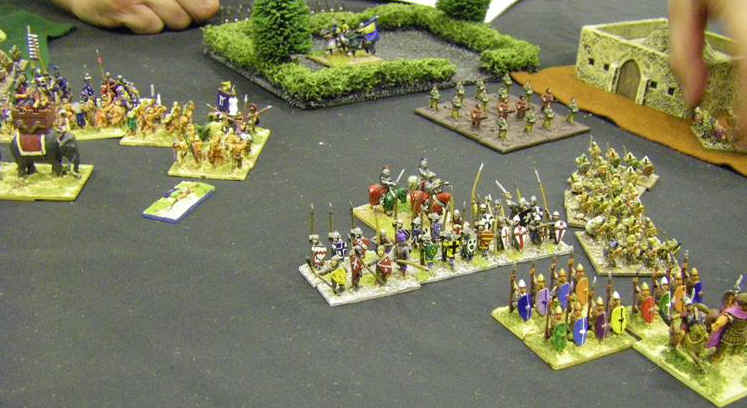
No matter how well it was going in the middle for the Celtiberians however, they still had another mountain to climb, as yet another block of knights charged into them. This time the fighting was more evenly matched, and both sides started to lose men and cohesion, both with generals urging them on to make that one final effort.
But by now my right flank had totally collapsed under the attack of the rampant Almughavars - after smashing both my own Spanish, then the Celts, they had dealt the decisive blow to also break the brave Bruttians and were now in full pursuit of my fleeing mob of an apology for an army

Eventually, with the knights at the very edge of being swept away, the Celtiberians suffered a traumatic morale test result of a double 1, and went from zero losses and disrupted and fighting a knight unit at half strength to 100% broken... when an unlikely victory seemed within their grasp !
With their demise, the game was effectively over
Post Game Analysis
My advantage in numbers of troops had been neutralized by terrain and clever deployment by the Spanish, and intimidated by the prospect of a dramatic redeployment I had been suckered into a rash attack. Even so, it could have almost come off as the Carthaginian army did almost manage to get enough of their troops into combat to overwhelm the better-quality Spaniards before they could get their powerful reserves out of the blocks. The problem was the inability of the Celts to stand up to the 8 light infantry bowmen in the middle of the park - compounded by their need to form a deeper formation to help sort out the traffic jam that developed as my army piled forwards piecemeal.
But ultimately, it was a tale of quality over quantity - and when I only managed to get even quantities, the Spaniards better qualities were always likely to prove the superior option !
Post Game Analysis from Hannibal
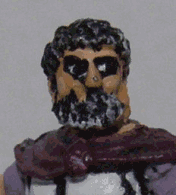
Well, another pathetic set of half assed excuses. The Romans would have flayed and executed you for such consistent incompetence - good job they aren't still around and its just the BHGS now eh? All these weasel words don't really hide the fact that you didn't have enough commanders in this army, and especially not for a fighting style that involves getting stuck in with lots of units at the same time. You needed generals to bolster those Gauls, and with your Numidians, and in 2 other places as well, period. I would not have made such a stupid mistake, and its only because I employed such a great spin doctor and exercised total control over any embedded journalists on my campaigns that the names of my sub commanders didn't end up being more famous than me (although at the time there was only the BBC world service anyway, and frankly if it didn't happen in the home counties they really didn't worry too much about accuracy of reporting anyway).
Don't miss any and see all the 15mm Ancients listed on ebay for the UK and the USA
Or check out my figure review page
View My Stats
The Ancient Army List Index
The Rise of Rome (280 BC to 25 BC) Mid Republican Roman ; Late Republican Roman ; Gallic ; Pyrrhic ; Later Carthaginian ; Ancient Spanish ; Later Macedonian ; Later Seleucid ; Later Ptolemaic ; Attalid Pergamene ; Numidian or early Moorish ; Pontic ; Early Armenian ; Parthian ; Later Jewish ; Illyrian ; Spartacus Slave Revolt ; Bosporan ;
Storm of Arrows - Western Europe in the Later Middle Ages (1300 AD to 1500 AD) Medieval French ; 100-yrs War English (Continental) ; 100-yrs War English (Britain) ; Later Medieval Scots ( Britain) ; Later Medieval Scots (Continental) ; Later Scots Isles & Highlands ; Medieval Welsh ; Later Anglo-Irish ; Medieval Irish ; Low Countries ; Later Medieval German ; Italian Condotta ; Swiss ; Free Company ; Medieval Burgundian ; Medieval Danish ; Medieval Swedish ; Medieval Castilian ; Medieval Crown of Aragon ; Medieval Portugese ; Later Granadine ; Navarrese ; Ordonnance French ; Wars of the Roses English ; Ordonnance Burgundian ; Santa Hermandad Nueva Castilian
Immortal Fire - The Greek, Persian & Macedonian Wars (550 BC - 146 BC)
Classical Greek ;
Early Achaemenid Persian ;
Lydian ;
Thracian ;
Syracusan ;
Early Carthaginian ;
Skythian or Saka ;
Kyrenean Greek ;
Late Dynastic Egyptian ;
Alexandrian Macedonian ;
Later Achaemenid Persian ;
Classical Indian ;
Early Successor ;
Early Sarmatian ;
Galatian ;
Hellenistic Greek ;
Graeco-Bactrian ;
Graeco-Indian ;
Indo-Greek :
Legions Triumphant - Imperial Rome (25 BC to 493 AD) Dominate Roman ; Principate Roman ; Foederate Roman ; Later Sarmatian ; Early German ; Dacian or Carpi ; Ancient British ; Caledonian ; Early Alan ; Jewish Revolt ; Sassanid Persian ; Kushan or Indo-Skythian ; Palmyran ; Early Frankish, Alamanni, Burgundi, Limigantes, Rugian, Suevi or Turcilingi ; Western Hunnic ; Early Visigothic & Early Vandal ; Early Ostrogothic, Herul, Sciri or Taifali ; Early Anglo-Saxon, Bavarian, Frisian, Old Saxon or Thuringian ; Gepid or Early Lombard ; Early Scots Irish ; Early Pictish ; Hephthalite Hunnic ;
Swords & Scimitars - The Crusades (1096 AD to 1311 AD) Early Crusader ; Later Crusader ; Fatimid Egyptian ; Georgian ; Seljuk Turk ; Cuman ; Komnenan Byzantine ; Post Latin Conquest Byzantine ; Ilkhanid Mongol ; Mamluk Egyptian ; Cilician Armenian ; Syrian States ; Khwarazmian ; Ayyubid Egyptian ; Middle Serbian ; Middle Bulgarian ; Medieval Cypriot ; Latin Greece ; Pecheneg ;
Eternal Empire - Eastern Europe and the Rise of the Ottomans (1300 AD to 1500 AD) Early Ottoman Turkish ; Later Ottoman Turkish ; Tatar ; Later Russian ; Later Serbian Empire ; Later Bulgarian ; Later Lithuanian ; Later Polish ; Later Teutonic Knights ; Catalan Company ; Middle Hungarian ; Moldavian or Wallachian ; Albanian ; Timurid, White Sheep Turcoman or Black Sheep Turcoman ; Later Hungarian ; Hussite ;
Decline & Fall - Byzantium and Islam (493 AD to 1071 AD) Early Byzantine; Maurikian Byzantine ; Thematic Byzantine ; Nikephorian Byzantine ; Later Moorish ; Later Visigothic ; African Vandal ; Italian Ostrogothic ; Early South Slav ; Lombard ; Avar ; Arab Conquest ; Early Bulgar ; Ummayad Arab ; Abbasid Arab ; Early North African Dynasties ; Khurasanian Dynasties ; Bedouin Dynasties ; Dailami Dynasties ; Pecheneg ; Ghaznavid ; Western Turkish (includes Khazar);
Wolves From The Sea - The Hairy European Dark Ages Post Roman British ; Early Welsh ; Later Scots Irish ; Merovingian Frankish ; Later Pictish ; Early Slavic ; Middle Anglo Saxon ; Astur Leonese ; Andalusian ; Early Navarrese ; Carolingian Frankish ; Viking ; Magyar ; Great Moravian ; Early Scots ; Rus ; Norse Irish ; Early Medieval French ; Early Medieval German ; Norman ; Early Polish ; Anglo Danish ;
Swifter Than Eagles - The Biblical Book Nubian ; Early Libyan ; Later Sumerian or Akkadian ; Early Nomad Allies ; Old or Middle Kingdom Egyptian ; Hyksos ; Mitanni ; Syro-Canaanite ; New Kingdom Egyptian ; Later Minoan or Early Mycenaean ; Hittite Empire ; ; Middle or Early Neo-Assyrian ; Later Mycenaean or Trojan ; Sea Peoples ; Philistine ; Phoenician Allies ; Neo-Hittite And Aramaean ; Later Hebrew ; Mannaean Allies ; Libyan Egyptian ; Urartian ; Median ; Neo-Elamite ; Proto-Arab Allies ; Cimmerian or Early Skythian ; Neo-Assyrian Empire ; Phrygian Allies ; Kushite Egyptian ; Neo-Babylonian Empire ;
Oaf of Fealty - Early Medieval Europe Feudal Catalan and Early Crown Of Aragon ; Early Hungarian ; Taifa Andalusian ; Feudal Navarrese and Aragonese ; Feudal Castilian Leonese or Portuguese ; Fanatic Berber ; Italo-Norman ; Feudal French ; Imperial German ; Feudal German ; Communal Italian ; Papal Italian ; Early Scots Isles And Highlands ; Feudal Scots ; Early Russian ; Feudal Polish ; Anglo-Norman ; Later Welsh ; Early Lithuanian or Samogitian ; Wendish Prussian or Estonian ; Early Medieval Frisia and Other Free Cantons ; Post-Viking Scandinavian ; Early Plantagenet English ; Later Sicilian ; Early Medieval Irish ; Early Anglo-Irish ; Early Teutonic Knights ; Mongol Invasion ; Early Granadine ; Middle Plantagenet English ;
Empires of The Dragon - China, Korea and Japan Erlitou-Shang Chinese ; Early Northern Barbarian Allies ; Early Zhou Chinese ; Yayoi Japanese ; Early Horse Nomad ; Ko Choson Korean ; Warring States To Western Han Chinese ; Qiang And Di ; Three Kingdoms Korean ; Eastern Han Chinese? ; Three Kingdoms W Jin And S Dynasties Chinese ; Kofun Nara Japanese ; Northern Dynasties Chinese ; Later Hindu North Indian ; Later Hindu South Indian ; Central Asian City States ; Western Wei To Early Tang Chinese ; ; Later Horse Nomad ; Tibetan ; Nepalese Allies ; Parhae Korean ; Late Tang To Five Dynasties Chinese ; Khmer Or Champa ; Thai Allies ; Nanzhao ; Pyu Burmese Allies ; Koryo Korean ; Early Heian Japanese ; Pagan Burmese ; Liao ; Song Chinese ; Xi Xia ; Ghurid Afghan ; Jin ; Late Heian To Muromachi Japanese ; Japanese Warrior Monk Allies ; Mongol Conquest ; Moslem Indian Sultanates ; Medieval Indonesian Or Malay ; Yuan Chinese ; Medieval Burmese ; Ming Chinese ; Yi Korean
Blood and Gold - The Americas Olmec ; Teotihuacan ; West Mexican ; Zapotec or Mixtec ; Toltec ; Chinantec ; Aztec ; Tarascan ; Tlaxcalan Confederacy ; Mayan ; Mochica ; Chanca ; Chimu ; Hatun-Colla ; Canari ; Inca ; Mapuche or Araucanian ; Amazonian Forest Tribes ; Tupi ; Chichimec ; Pueblo Culture ; Mound-Builder Culture ; South-Eastern Woodland Culture ; Timucuan ; Eastern Woodland Culture ; Plains Culture ; Pacific North-West Culture


